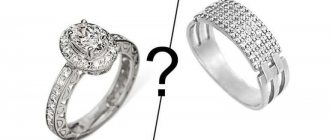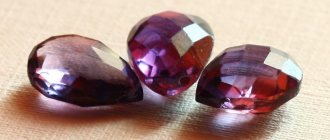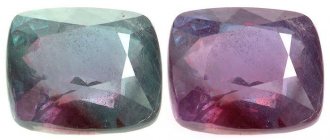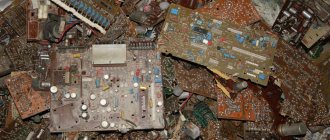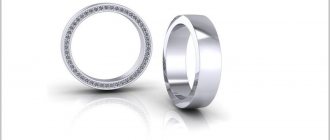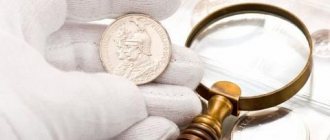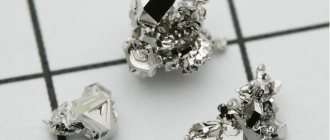March 20, 2021
Just recently, one gram of palladium was cheaper than silver. Now it is the most valuable metal of all available - it costs 7,000 rubles per gram, which is almost twice as much as gold. There is now a special relationship with palladium; those deposits that were previously unprofitable to exploit are being rediscovered and actively developed. Radio scrap buyers also got involved.
Previously, they practically did not accept palladium, since it was very cheap. Now there is literally a hunt for radio components containing palladium. It is worth telling in more detail about which radio components contain the largest amount of this valuable metal and how to distinguish it from other metals.
Finding in nature and prey
Platinum and palladium are mined from primary and placer deposits. How are they different from each other? In primary deposits, the metal is part of minerals and is extracted as a by-product during the processing of nickel or copper ores. Placer deposits are permitted bedrock ore deposits where Pd has been released and accumulated as nuggets.
Palladium mining from alluvial deposits accounts for about 2% of the global production of the element. The largest of them are located in the Ural and Far Eastern regions of Russia, Canada, the USA, Australia and Colombia. The remaining 98% of Pd is extracted from the bowels of the earth at primary deposits of copper-nickel, platinum and chromium ores.
The world leaders in the extraction of precious metals from such deposits are Russia and South Africa. The undisputed first place among the mining enterprises of the industry is occupied by MMC Norilsk Nickel, producing more than 40% of the world's Pd volumes. The metallurgical plant extracts metal as a by-product during the extraction of its main products - copper and nickel. Among the mining assets of Norilsk Nickel, which have the potential for palladium reserves, are deposits on the Taimyr Peninsula - Talnakhskoye, Oktyabrskoye and Norilsk-1, as well as on the territory of the Kola Peninsula.
The next most important source of metal in the world is usually called the Bushveld complex, located on the territory of the Republic of South Africa. The territory of the deposit has the largest reserves of platinum group metals in the world.
Pd in nuggets has impurities of other precious metals, but it itself is often one of the elements of native gold or platinum. During palladium mining in Norilsk, geologists discovered palladium platinum - a compound of platinum and its “younger brother” in a ratio of 60%/40%. Another similar alliance, this time with gold, was found in Brazil. Such gold with a 10% Pd content is called porpecite: visually distinguishing it from pure yellow metal is also problematic.
What minerals contains palladium? You can see them in the sample photos. The most famous minerals containing Pd are palladite, stannopalladite, braggite and potarite. Some compounds even today do not have names, since they have been little studied due to their rarity.
The element Pd is a component not only of the interior of our planet, but also of space objects: palladium is found in iron and stone meteorites arriving on Earth.
How does mining happen?
The extraction process is divided into several stages:
- Extraction of ore containing palladium from deposits.
- Enrichment.
- Extraction of palladium in its pure form.
Industrial mining
The extraction of a rare and expensive element occurs in primary and secondary deposits. At primary sites (primary) platinum-containing ore is extracted. Placer (secondary) objects arise as a result of the destruction of primary deposits. Here palladium is extracted in its pure form without impurities.
It is customary to distinguish 2 types of deposits for development:
- Open (quarries).
- Closed (mines).
When using the open method, the development of a special soil quarry is used. To extract metal from the ground, specialized expensive equipment is used. Using vehicles, the ore is transported to locations for further processing.
It is worth noting that this metal is found in minute quantities in cosmic bodies.
To mine palladium using a closed method, special mines are created underground. Holes for explosives are drilled in a special layer. All that remains is to do the modification mechanically or manually.
Next, a conveyor belt is used to help transport the ore to the surface. Storage is carried out in open warehouses. Once sufficient mass has been accumulated, it is transported to the place where processing takes place.
Enrichment
It involves processing the resulting ore to obtain a high-quality, impurity-free concentrate that contains valuable metals. A ton of ore obtained contains only up to 6 grams of precious metals. To increase the concentration of palladium, the artificial principle of enriching ore with platinum minerals is used.
The ore is first crushed to a powder using special equipment. Water and special reagents (usually nitric acid) are added to the resulting product. Next, a high-pressure air stream is used.
Thanks to ionization, mineral molecules begin to be attracted to air bubbles. As a result, the bubbles float to the surface along with the precious particles, forming a foam-like mass, which is collected in a special container and then dried.
Once the mixture dries, a concentrate with a high platinum content appears. One ton contains up to 1 kg of metal without impurities. Further processing is carried out in an electric oven at a temperature of 1500 degrees. A slag mass is released from the by-products and must be removed.
The mass resulting from firing is sent to a converter furnace. It eliminates sulfur and iron. In 1 ton of ore, the output is up to 1.4 kg of pure metal without unnecessary impurities.
Affination
After processing in the converter furnace, the concentrates are sent to specialized refining plants. Modern equipment and the latest technologies help to isolate pure palladium from the resulting mass.
Affination is a production process that results in the separation of a pure substance from the total mass. An ingot or powdery mass is formed from the clean resulting mass to be sent for transportation to a storage location.
Excluding transportation time, the total production process averages 6 weeks.
Where is refined metal accepted?
Pure palladium is accepted at a price of up to 2,700 rubles per gram.
However, it should be remembered that illegal trafficking in precious metals is prohibited by law . And if you are refining palladium at home, you are unlikely to have a package of permits.
For law-abiding citizens, there is only one way out of the situation - to hand over radio components containing this element to specialized purchasing points that have a license for circulation .
In companies buying metal, there is the following division:
- knitting needles, needles, palladium contacts and others (alloy content 18-28%) - cost per gram 230-360 rubles ;
- in products with a content of 80%, for example, winding from strings - 1000 rubles .
Separation of palladium from gold
To carry out such a chemical reaction, it is necessary to place the starting material in a mixture consisting of concentrated nitric and hydrochloric acids. This composition is known as “Royal Vodka”. If you have a palladium-silver alloy on your hands, then nitric acid is used as a reagent.
Distilled water is added to the hydrochloric-nitrogen solution. Next, the mixture is kept in this form for about a day, during which the substances are broken down. At the end of the allotted time, a precipitate in the form of silver chloride forms in the container, which should be filtered.
To separate the palladium from the gold remaining in the composition, ammonia is added to the mixture. The container should again be left for two days. Next, the gold solution is filtered. It is recommended to place it in a separate container and restore the precious metal using zinc.
The remaining palladium filtrate is exposed to a small amount of hydrochloric acid. As a result of this reaction, a precipitate appears that has a yellow tint with an admixture of orange. After a few hours, it must be filtered, dried and calcined, heating to a temperature of 500 degrees. The result of this operation will be a powder consisting of palladium.
Application
The precious metal has found application in jewelry; its density is close to silver - 10.49 g/cm³, melts at a temperature of 1552 °C, boils at 3980 °C. Heated raw materials are welded, easily forged, and can be processed at a temperature of 22-25 °C. The mechanical characteristics of pure Pd are not constant; they are improved by additives .
Jewelry with a high level of mechanical resistance is made from 850-grade palladium. The cost of men's (women's) chains is 7-70 thousand rubles. Cufflinks and rings with onyx, diamond, and agate are in constant demand among men. For women, the trend is hairpins, earrings, brooches, rings with or without inserts.
On a special date, the event is given:
- pendants;
- bracelets.
Jewelers make expensive exclusive models to order ; wedding rings from the latest collections of leading jewelry houses in Europe and America are valued at several thousand dollars.
13% Pd is present in 583 white gold
Where else can you find it?
Here I would like to dispel the myth about the legendary Singer sewing machine, the patent for which was received by its American inventor Isaac Singer in 1851.
What kind of “treasures” were they looking for in this mechanism?
For many years, people believed that the machine had a component (drive shaft) made of precious metal , the purpose of which was to resist corrosion.
Palladium was one of the group of precious metals from which the drive shaft of the machine was supposedly made.
In fact, the fact of the presence of gold, platinum, and palladium in the Singer sewing machine has not been established . This applies to German and Russian-made models released from the factory assembly line in Podolsk before and after the revolution.
But it makes sense to carefully examine a deteriorated engine from a Pobeda car if its numbers have not been changed and are in this range - from “20-0045203” to “20-0056152”.
The fact is that relatively recently, while sorting out the archival rubble of the Gorky Automobile Plant, quite interesting documents were discovered - author's certificate No. 86642. This interesting document dealt with the advantages of using palladium alloys in some automotive components .
And not an unfounded description of the advantages, but with complete evidence:
- the service life of palladium alloy mechanisms (shaft, bearings) increases by 45% relative to steel analogues;
- engine operating time in the absence of appropriate lubricants increases by 8 times;
- immunity of Pd to sulfuric acid, which was part of cleansing oils, for example, AKp-5.
As a result, for more than a month in 1950, cars equipped with palladium camshafts rolled off the GAZ assembly line. more than 2 thousand cars in this way , the innovative proposal was criticized.
First of all, from the point of view of economic benefits, steel in any version is much cheaper than palladium.
The technological process for the production of steel elements is intellectually simpler and has already been established.
The result is that everything was returned to normal, and the remaining palladium alloy shafts were “thrown away” at retail as spare parts.
Of course, finding a “Victory” with the “engine” of the corresponding series is not an easy task . However, the lucky one will get a good reward - now the cost of that very palladium shaft is a fortune.
It is much easier to find gas masks that used filters marked “DP-2”. For example, the GP-4-U gas masks, familiar from school.
In these filters, the content of powdered palladium is 2 g. It would seem that the weight is insignificant. However, this is not the camshaft from Pobeda to look for.
origin of name
Named after the asteroid Pallas, discovered by the German astronomer Olbers in 1802, that is, shortly before the discovery of palladium. In turn, the asteroid is named after Pallas Athena from ancient Greek mythology. Palladium, or Palladium, is the legendary wooden image of Pallas Athena that fell from the sky; according to the prophecy of Helen (son of Priam), Troy will remain indestructible as long as this talisman is kept within its walls. According to legend, only after the goddess’s favorites, Odysseus and Diomedes, stole Palladium during a night raid, did this stronghold fall.
Refining of parts containing Pd
There are several ways to extract palladium from various radio components. There are two methods you can implement at home :
- electrolytic;
- chemical.
The first method is to use sulfuric acid as an electrolyte, cathode and anode , as well as a power supply.
The second method involves the use of a chemical reagent with the expressive name “Royal Vodka”.
It is a mixture of hydrochloric and nitric acid .
You can purchase it or make it yourself if you have the ingredients.
Both processes are unsafe, but to varying degrees.
In any case, it is necessary to have personal protective equipment:
- rubberized apron;
- gloves;
- respirator;
- glasses.
All work is carried out using a fume hood or outdoors . Detailed information on the extraction of palladium from radio components and other elements can be found in a separate article.
Where is palladium mined?
In 1803, British chemist William Wollaston was the first to describe what naturally occurs in palladium. The scientist obtained the noble metal from platinum ore by dissolving it in aqua regia and adding mercuric cyanide.
Explored reserves of primary Pd deposits on the territory of the Taimyr Peninsula amounted to 62 million ounces
Raw materials for industrial and jewelry production are mined in Russia, North America (Canada, USA), Africa (South Africa), Europe (Austria) in placer and primary deposits. In total production, nuggets account for 2%; 98% of Pd is contained in platinum group ores .

